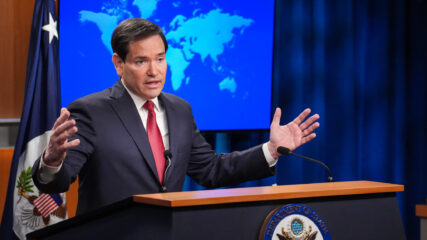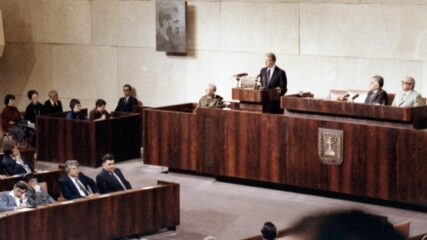Paul Rivlin, Moshe Dayan Center, May 29, 2018
https://dayan.org/content/gaza-crisis
With permission; read the full article at the Moshe Dayan Center.
At the end of March 2018, a wave of violence broke out on the border between Israel and Gaza . It began on March 30, when an estimated 30,000 Palestinians gathered for an event that was billed as the beginning of a six-week protest against both the longstanding blockade and their inability to return home to what is now Israel. By May 15, over 100 Palestinians had been killed. Some of those killed have been identified by Israel as members of terror groups; Hamas itself acknowledged that 50 were its members.[1]
The Palestinian side of the Kerem Shalom crossing has been destroyed by Palestinian rioters. It was the main, and often the only, passage between Israel and the Gaza Strip. Each day, hundreds of trucks travelled through it, bringing goods including medical supplies and building materials. On May 11, at the end of that day’s mass protest, hundreds of Palestinians broke into the Gaza side of the crossing and set fire to the Strip’s only fuel terminal and a conveyor belt used for raw construction materials. Two conveyor belts which brought animal feed into Gaza were also wrecked.[2]
Hamas organized the “Great March of Return” protests as part of a season of weekly rallies scheduled to continue until Nakba Day on May 15 – the date traditionally commemorated by Palestinians for their displacement in 1948. Nakba Day commemorations were moved forward this year to coincide with the move of the US embassy in Israel to Jerusalem and to avoid falling during Ramadan. The protests helped to focus international attention on Gaza and have resulted in Israel’s leadership reconsidering how to improve the humanitarian situation in the Strip. Palestinians have expressed widespread support for the border protest.[3]By promoting the protests, the Hamas has tried to return to a leadership role in the Palestinian arena, while the Palestinian Authority (PA) and Fatah in Ramallah lag behind.
Hamas leaders in the Gaza Strip have recently conveyed messages to Israel indicating their willingness to negotiate a long-term cease-fire in the enclave.[4] The recent failure of the reconciliation talks with the Fatah movement and the Palestinian Authority (PA) that runs the West Bank wrecked Hamas’ hopes of easing the economic crisis in Gaza. The PA has withheld funds that it had used to pay civil servants in Gaza, thus deepening the financial crisis there. The 83-year-old Palestinian President Mahmoud Abbas officially ‘buried’ the reconciliation talks after a failed assassination attempt against the Palestinian Prime Minister, Rami Hamdallah, and PA intelligence chief, Majid Faraj on a rare visit to Gaza this past March.[5]
In the absence of intra-Palestinian reconciliation, it is quite unlikely that Hamas will gain larger concessions from Israel that might help ease trade restrictions on Gaza. Shlomi Eldar argued recently that Hamas’ political leadership is aware that without a breakthrough on this front “the organization will no longer be able to run the Strip, as the popular protests by desperate residents would not only be directed at Israel but might turn against Hamas.”[6]
Recent violence reflects deep resentment in the Gazan population and an attempt by Hamas to channel frustration away from its own military and civilian failures. In military terms, Israel has developed answers to the threat of missiles and that posed by tunnels (routed under the border into Israel where they were designed to facilitate attacks). Riots on the border and the use of kites loaded with explosives can be seen as the latest, desperate attempt to threaten Israel when all else has failed. The civilian failure of the Hamas is a direct consequence of its military ventures. The missiles and then the tunnels absorbed huge resources that could have been used to develop Gaza, or for reconstruction after the 2014 war.
Demographic pressures lie behind much of what is happening in Gaza. In 1948, 250,000 Palestinian refugees fled to Gaza, where the existing population was 80,000. Today, the population of Gaza is about 1.9 million of whom 1.3 million (68%) are refugees. Palestinians are the only people to retain refugee status generation after generation as a result of United Nations support.
As is shown in Chart 1, Gaza has an extremely young population. The chart shows that there are 600,000 males and about 550,000 females aged up to 24 years. Together they account for over 60 percent of the population. The link between a large young population and political stability has been explored by political scientists and demographers. A large share of young people in the population is associated with more political tension and even revolt. Gaza presents an extreme case of this phenomenon.[7]

Closely related to demographic pressures are economic ones. In March 2018, the World Bank concluded that over the last twenty years, the volatility of economic growth in Gaza was largely due to political developments. In 1994, Gaza was the first territory to be transferred to the authority of the Palestinians, by Israel after the signing of the Gaza-Jericho agreement that followed the Oslo accords. Between 1994 and 1999, Gaza enjoyed growth rates averaging six percent a year. This was made possible by inflows of capital, increased investment, and a significant improvement in the security situation. The positive trend was interrupted after the outbreak of the second intifada in 2000 when the economy went into recession with growth rates slipping to an annual average of negative eight percent until 2002. Several years after the second intifada, the economy started to recover. However, the Strip was hit again with the turmoil surrounding the internal divide following the parliamentary elections of 2006, where Hamas won 74 out 132 seats in the Palestinian legislative council. The economic decline got deeper with the Israeli decision to impose a full blockade on Gaza in 2007 after the takeover by Hamas and the beginning of its missile attacks.
Outbreaks of armed conflict in 2008, 2012 and in 2014 have all damaged Gaza’s economy. After the 2014 war, the economic growth rate contracted by 15 percent. The crackdown on illegal tunnel activity with Egypt in 2013-14 also affected economic activity. Inflows of aid for reconstruction after the 2014 war enabled the economy to rebound, with average growth rates reaching eight percent in 2015-2016. However, the lack of additional aid for reconstruction and a significant decline in consumption in 2017 caused GDP growth to fall to only 0.5 percent. Given the population growth rate of over 2 percent a year, this meant that income per capita declined.
As a result, Gaza’s average growth has been lower than all comparators. Average annual growth in Gaza over the last two decades was only about two percent while the annual average in the Arab world was four percent and in both low income and low-middle income countries worldwide it was five percent. With a relatively educated population, access to the sea and proximity to a developed country, Gaza’s GDP growth should have been at least in line with the West Bank’s, which has grown on average five percent per year over the last two decades. Growth rates in Gaza exceeded those in the West Bank prior to 2006/7, but since then the impact of the blockade, conflict with Israel and the internal conflict between the Hamas and the Palestinian Authority has resulted in much slower growth in Gaza.
The economy has been deindustrialized with an erosion of its productive base. The manufacturing sector, which is one of the key drivers of export-led growth globally, fell from 16 percent of the GDP in 1994 to eight percent currently. Agriculture also declined from 11 percent of the GDP to below five percent. The rapid decline in these productive sectors was not compensated for by growth in high value-added services that could integrate the economy into regional and global markets. Most of the increase in output was in the public sector where output rose from 12 percent of the GDP in 1994 to about 30 percent at present. Growth in public sector output was not accompanied by an expansion of sectors with potential to generate sustainable growth and revenues to continue the provision of public services over the medium and long term, raising serious questions about the sustainability of economic growth. In addition to the deterioration, the isolation of the labor force due to restrictions on the movement of people is expected to lead to an erosion of Gaza’s human capital.
Unemployment in Gaza has been on the rise and is currently amongst the highest in the world. The average rate disguises a particularly high youth unemployment rate. In the early years after the signing of the Oslo Accords, unemployment declined sharply due to increasing employment opportunities in Israel. After the second intifada in the early 1990s, unemployment rose sharply reaching 38 percent. The 2007 blockade led to a sharp increase in unemployment to 41 percent. By the end of 2013, the crackdown of the illegal tunnel trade between Gaza and Egypt led to a significant loss of employment opportunities. Since then, the combination of the Israeli blockade and the impact of the 2014 war have increased the unemployment rate still further and it currently stands at around 44 percent.
Unemployment amongst those aged between 15-29 is particularly high at 61 percent. Due to the lack of employment opportunities, the public sector in Gaza has been the largest single employer, employing 36 percent of those in employment. This rate is considered extremely high even when compared to the West Bank’s, which currently stands at 15 percent.
As poverty is highly correlated with lack of employment, it is not surprising that a large share of the Gazan population lives below the poverty line. According to the latest available data for 2011, poverty in Gaza stood at 39 percent – more than twice as high as that in the West Bank. In fact, the poverty gap between the West Bank and Gaza has always been high. In 2004, the poverty headcount in Gaza was 29 percent higher than in the West Bank. By 2007, this gap had expanded exponentially to reach 145 percent after the blockade was imposed. While the gap declined after 2009, it continued to be over a 100 percent and never returned to its pre-crisis level.[8]
In 2017, 29.2% of Palestinians lived below the poverty line, according to the Palestine Central Bureau of Statistics. The poverty line for household of five members (two adults and three children) was 2470 shekels ($686) and 16.8% of the Palestinians suffered deep poverty in 2017, and the deep poverty line was 1974 NIS ($548). The poverty rate was 13.9% in the West Bank, while in the Gaza Strip as it was 53.0%. Some 5.8% of individuals were below the deep poverty line in the West Bank and 33.8% of those in the Gaza Strip. Poverty among individuals in the Gaza Strip rose from 38.8% in 2011 while 53.0% in 2017 while in In the West Bank, poverty decreased from 17.8% in 2011 to 13.9% in 2017. In the West Bank, there was a decrease in deep poverty, from 7.8% in 2011 to 5.8% in 2017. The significant increase in poverty indicators in the Gaza Strip was the cause of the increase in the overall poverty indicators of both authorities. In 2017 in the West Bank and Gaza the average poverty rate was 29.2%.[9]
Hamas has been in conflict with Israel since its foundation, and often at odds with the PA in the West Bank as well as other Arab states. Its desire to control all of Palestine implies the destruction of Israel (which it explicitly calls for in its 1988 charter) and its desire to set up a religious state, putting it into conflict with the Palestinian Authority. Its support for, and erstwhile association with, the Muslim Brotherhood[10] and support for terrorists in the Sinai has put it in conflict with Egypt. Its links with Iran have generated further hostility in Israel, the Sunni Arab world and the West. The almost permanent state of conflict that Gaza has suffered since Hamas took control in 2007 contrasts with the situation in the West Bank and threatens Hamas from within. It has yet to face an Arab Spring, but that cannot be ruled out. Increasing tensions with Israel or taking over popular protests is an Orwellian way of distracting attention from its own failures, but the risks are huge.
Many in Gaza and elsewhere blame Hamas for the destruction that has taken place. This is because its achievements are non-existent, with the possible and dubious one of having prevented more extremist Salafi groups taking control. Hamas has proved itself to be unable to improve the material welfare of the Gaza population. Since its founding in 1988, the political strategy of Hamas has been to mobilize popular support against perceived enemies, rather than to focus on technical solutions to building a strong economy. While this strategy has been able to control the population in Gaza, the risks to stability have been demonstrated in the recent events on the border. The economic situation in Gaza is dire and the political situation is hopeless. Those who have lost hope in the future feel they have nothing to lose from violence.
The dilemma that Hamas faces does not necessarily serve Israel. The problems of two million Palestinians in Gaza will remain an issue for Israel even if Hamas eventually loses power. The Israeli government does not want Hamas to be replaced by Salafists and/or chaos. It has therefore tolerated Hamas despite constant conflict. It does not believe in the creation of a Palestinian state and is therefore content with the division of the Palestinians between two authorities. The complete absence of political hope is, however, something that Israel should address, if only to attempt to counter Hamas propaganda and possibly reduce the level of violence that is damaging its international image.
[1] Alastair Jamieson, “Hamas says most of protesters killed by Israel in Gaza were members ,” NBCNews, May 17, 2018.
[2] Judah Ari Gross, “Israel to reopen Gaza crossing after rioters burn it for 3rd time ,” Times of Israel, May 15, 2018.
[3] Asa Winstanley, “The Palestinians have started their Great March of Return ,” Middle East Monitor (Opinion), March 31, 2018.
[4] Amos Harel, “Hamas in Message to Israel: Willing to Negotiate Long-term Truce ,” Ha’aretz, May 7, 2018.
[5] Shlomi Eldar, “What’s behind Hamas’ offer of cease-fire to Israel? ” Al-Monitor, May 8, 2018.
[6] Ibid.
[7] Lionel Beehner, “The Effects of ‘Youth Bulge’ on Civil Conflicts ,” Council of Foreign Relations, April 13, 2007.
[8] Economic Monitoring Report to the Ad Hoc Liaison Committee March 19, 2018, The World Bank www.worldbank .org.
[9] Palestinian Central Bureau of Statistics, “Levels of Living in Palestine, 2017 ” Report, No author, no date.
[10] Nidal al-Mughrabi and Tom Finn, “Hamas softens stance on Israel, drops Muslim Brotherhood link ,” Reuters, May 1, 2017.









